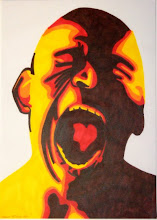
{WRITTEN FOR PROF. TOM SHERMAN'S VIDEO ART HISTORY CLASS}
{March 2007}
Typically, when sizing up video pieces I'm a sucker for both multi-monitor array and rapid, carefully manipulated editing and color. There are instances, however, when a slower piece can quietly finagle its way into my prized work list. The best example of this being Steina Vasulka's "Pyroglyphics" (1995).
Inherently, fire will always engage the natural pyromaniac in most persons, especially destructive art students. Yet Steina does not flog a mangled trope by documenting metallurgy, but instead renders both a playful and meaningful context to the most raw and simplistic recording of an element. I found myself drawing associations from the work I'm almost totally sure Steina had no intention of displaying.
As the beautifully paced flames burnt out of the projector, I was finding myself (and you'll have to take my word on this) embarrassingly tearing up, wrapped in thoughts about the Holocaust ovens, and then on to cremating loved ones, and other depressing events that Steina had evoked purely by accident in my overemotional, over-calculating noggin. Being able to inadvertently make a nineteen-year-old man cry with completely separate artistic intention is one form of effectiveness in my view, but other artists, specifically late modernists in the eighties and nineties, have made work that spoke new meanings for itself without being prompted by their creators.
In 1991, Stan Douglas' "I am not Gary" was broadcast in America, unintentionally provoking a handful of viewers into making puzzled phone calls, asking broadcasters if the piece was a part of the prescribed entertainment as a "quiz" or candid, or perhaps simply an editing slip up. Once the work and its look-a-like protagonist's subversive imitation were unmasked to the concerned viewers as an "art piece," their bombinate preconceptions were soothed and the work's power and intention were diminished.
The piece was still greatly effective. Much like Vasulka's unexpected, highly specific emotional reaction (so easily yanked out of my whimpering psyche,) in its casual disruption of a previous state of comfortable convention and cozy pattern, Douglas got something out of viewers that he hardly had a hand in, with modern television programming and the affinity of daily broadcast material taking most of the credit.

A second piece that I find extremely engaging and successful was shown to me both in video art history class, as well as video sketchbook. Ulrike Rosenbach's "Wrapping with Julia" (1972) made the one take beautiful for me again, rather than trapping and exhaustive as is the case with many one takes. Until seeing this tape, the majority of one take videos thrust upon me in class wore a rough patch in my skull with their use of image and audio redundancy for its artistic novelty, while obviously lacking in concept or intellectual dimension.
This piece, however, stood perfect and quiet to me, with no text or narrative lorded over the image, nor stuttered monologue uncomfortably gabbed out for eons by the artist (a typically Canadian habit, most notably in the work of Vera Frankel and Jane Parker, but also shared globally, in tapes like Vito Acconci's "Theme Song", or Lisa Steele's "A Very Personal Story"). Instead, Rosenbach alternately chooses to celebrate the intelligence and diversity of her audience.
By allowing her construct to act as a fountainhead for our own associative interpretations, she lets the image parent countless undefined connective relationships to each individual who watches. Along with this humbling of the artist-to-viewer relationship, Rosenbach is also successful in beautifully meshing recurrent sound and unvarying motion without it getting the least bit taxing.
First the simplicity in her composition and warm organic imagery of the young girl wrapped slowly in gauze by her bare mother gracefully contracts the attention of the audience. The gentle portrait strikes a caring maternal tone for me, but as I explained, this is my own individual connection that her simple plain and effortless piece provides.
Second, her tape does this while never dropping to the hackneyed crutch of shock value, or overtly sexual expose (not that these are always bad, just difficult to use effectively). There's no sporadic, unexpected bodily fluid, or cooking oil, or unleaded gasoline splattering the pair at random, purely to disgust or unsettle the viewer. There's no "kiddy porn" vibe, female exploitation, or sexual agenda embedded in the work. There's no threadbare manifesto inherent in the gestures of the pair. All that is fixed and implicit is the performance, appearance, and duration.
Lastly, the piece is totally replicable, like many other straightforward tapes (Martha Wilson's "Four Short Performances", Bruce Nauman's "Lip Sync"). The distinctly European approach of "Wrapping with Julia" comes off as much more sensual than these other similar easy-to-replicate pieces. Though like them, it effectively acts much like a musical score, or a documented object of thought, making the perceptual experience of watching the tape both enjoyable and conceptually dynamic as well.

No comments:
Post a Comment